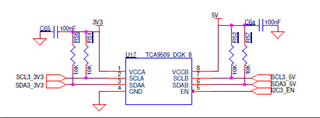Other Parts Discussed in Thread: EK-TM4C1294XL, TCA9555,
Hello,
We are trying to interface an LED display board driven by TCA9555 which is I2C based to TM4c1294 Launchpad ( EK-TM4C1294XL). We are able to interface the TCA9555 directly and able to drive LEDs which are working. However it works for only for 15 minutes and after that the TCA9555 is out of control and does not respond at all. Since we are using a cable of 20 cm we tried to put a repeater in between based on TCA9509. However once the A side of TCA9509 is connected to controller, there is no pulses on clock (SCL) and data(SDA) and hence no communication, We removed the inputs side pull up of TCA9509 and checked
Regards,
Ramesh

DocScanner Apr 12, 2023 5-37 PM.pdf
In TC9509 En pin is actually pulle up.'


